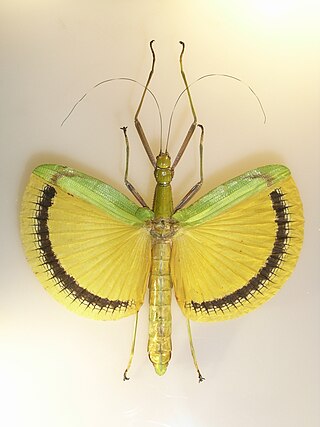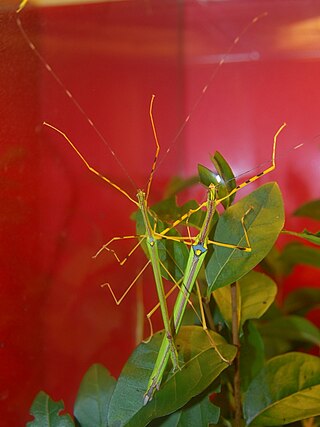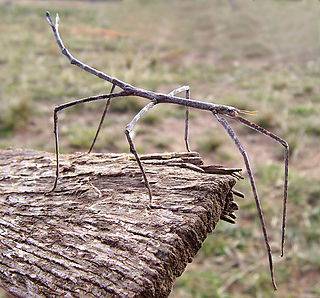Hermarchus is a genus of very large stick insects within the order Phasmatodea and the tribe of Stephanacridini. Known species occur in New Guinea, Fiji, Australia, Philippines and New Caledonia.

Necrosciinae is a subfamily of the stick insect family Lonchodidae, with its greatest diversity in South-East Asia.

The Heteropterygidae is a family of stick insects belonging to the suborder Euphasmatodea. Species can be found in Australasia, East and Southeast Asia. About 150 valid species have been described.

Necroscia is an Asian genus of stick insects in the family Lonchodidae and tribe Necrosciini. Species have been recorded from South-East Asia.
Ramulus westwoodii is a species of stick insect first described by James Wood-Mason in 1873 and named in honour of John O. Westwood.

Phasmatini is a tribe of stick insects in the family Phasmatidae. There are more than 40 described species, found in Australasia, and Asia

The Obriminae are the most species-rich subfamily of the Phasmatodea family Heteropterygidae native to Southeast Asia. It is divided into two tribe.

Datamini is the only tribe within the subfamily of the Dataminae from the order of the Phasmatodea. The representatives of this subfamily are on average not as large as those of the other two subfamilies belonging to the family of Heteropterygidae.

Paramenexenus is a genus of Asian stick insects belonging to the family Lonchodidae, erected by Josef Redtenbacher in 1908.

Heteropterygini is the only tribe within the subfamily of the Heteropteryginae. With 19 representatives described, this subfamily includes the fewest species of the three subfamilies, but includes the largest and most striking species of the family.

The genus Dares, which is mainly native to Borneo, combines relatively small and mostly dark-colored Phasmatodea species.

The Obrimini are the most species-rich tribe of the Phasmatodea family of the Heteropterygidae native to Southeast Asia.

Theramenes is a genus of medium-sized stick insects in the tribe Obrimini, which is native to the Philippines and to the Indonesian Talaud Islands.
Brasidas foveolatus is a species of stick insects from the family Heteropterygidae native to the Philippine archipelago Mindanao.
Tirachoidea biceps is a species of stick insect in the order Phasmatodea. It is endemic to Java, Peninsula Malaysia, and Sumatra. Females of this species average 195 mm (7.7 in) and are apterous. Although males are fully winged, their flight capability is poor. Tirachoidea biceps was previously known as Pharnacia but is distinguishable by two bumps on their hind head.

Anchiale modesta is a medium-sized stick insect from Papua New Guinea.
Anchiale marmorata is a medium-sized stick insect found in Papua New Guinea. This species is very similar to A. modesta but females are smaller in size and have shorter legs.
Pachyscia is a genus of Asian stick insects in the tribe Necrosciini, erected by Josef Redtenbacher in 1908. Species have been recorded from Vietnam and China.

Josef Redtenbacher was an Austrian entomologist and teacher. He specialized in the orders of Orthoptera, Phasmatodea, Mantodea (mantis) and Blattodea (cockroaches), which are classically summarized as Orthoptera, as well as in the earwigs (Dermaptera), which are not assigned to the Orthoptera, especially from Austria-Hungary and Germany.

Tisamenus ranarius is a stick insect species (Phasmatodea), in the family of the Heteropterygidae native to the Philippines.













